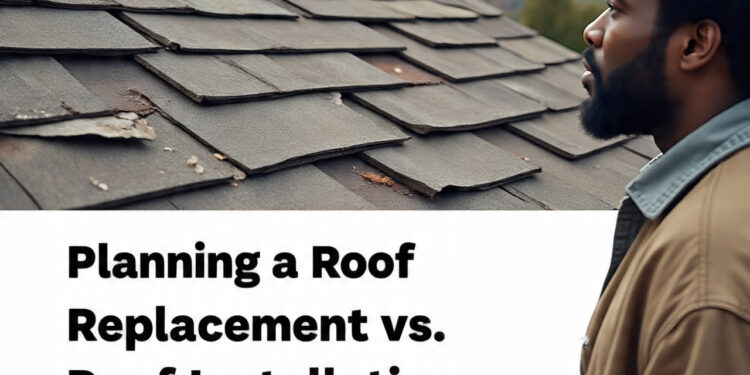Every home eventually reaches a point when attention must turn to the roof. For some, that means replacing an aging system that has protected the property for decades. For others, it involves installing a brand-new roof on a recently built or remodeled home. While the two processes may sound similar, roof replacement and roof installation each come with unique challenges, costs, and benefits. Understanding the differences helps homeowners make informed decisions that protect both their investment and peace of mind.
Both processes serve one essential purpose: keeping your home safe and weather-resistant. But the methods, materials, and timing vary greatly between the two. Choosing the right approach ensures not only durability but also energy efficiency and long-term savings. That’s why experts like Neal Roofing & Waterproofing emphasize education and planning before any roofing project begins.
Starting From Scratch: The Nature of Roof Installation
Roof installation is typically part of new construction or major additions to an existing home. In this scenario, there’s no old roofing to remove—just the clean structure of the building ready to be covered. This makes installation somewhat more straightforward than replacement, though precision is equally critical.
A successful roof installation depends on selecting the right materials and ensuring that every component—from the decking to the shingles—is installed according to manufacturer specifications. Proper ventilation, insulation, and underlayment are essential to the system’s performance and lifespan. Each decision made during installation determines how well the roof will protect the home for decades.
The Complexity of Roof Replacement
Roof replacement, on the other hand, involves removing an existing roof and installing a new one in its place. This process is more complex because it begins with demolition. Old shingles, underlayment, and damaged wood must be carefully stripped away before rebuilding the structure.
During this phase, hidden issues like rot, mold, or water damage often come to light. Addressing these problems ensures the new system isn’t just a cosmetic upgrade but a complete restoration of the home’s protective barrier. Roof replacement may be more labor-intensive than installation, but it provides an opportunity to correct past issues and modernize materials for improved performance.
Cost Considerations and Long-Term Value
Cost is a significant factor in both roof replacement and roof installation. Installation on new construction tends to be more predictable since there’s no removal involved. Replacement, however, includes the cost of tearing off old materials and repairing any underlying damage discovered during the process.
Despite the higher upfront cost, replacement can offer tremendous value. A new roof increases curb appeal, boosts energy efficiency, and raises property value. Contractors like Neal Roofing & Waterproofing often remind homeowners that a well-executed roof project should be viewed not as an expense, but as an investment that delivers long-term returns through durability and reduced maintenance.
Timing the Project Wisely
Timing plays a major role in both replacement and installation. Roof installation usually aligns with the broader construction schedule of a new build, coordinated with other structural work. Roof replacement, however, often occurs under time pressure—especially if leaks or storm damage are present.
Planning ahead helps homeowners avoid emergency replacements and allows time to choose the best materials and contractors. The ideal seasons for roofing projects are typically spring and fall, when temperatures are moderate and weather is more predictable.
Choosing the Right Materials
Material choice is one of the most impactful decisions in any roofing project. Asphalt shingles remain a popular and cost-effective choice, offering durability and style versatility. Metal roofing provides superior longevity and energy efficiency, while tile and slate roofs deliver distinctive aesthetics and exceptional lifespan.
For roof replacement, the existing architectural style and structure may influence material choice, especially if the home was built to support a specific type of roof. For installation, homeowners have the freedom to design from the ground up. Regardless of the project, selecting high-quality materials ensures a roof that performs well and enhances curb appeal.
Environmental and Energy Efficiency Benefits
Modern roofing technologies have made both installation and replacement more sustainable. Roof replacement often involves upgrading old systems that lack proper ventilation or insulation. These improvements can significantly reduce heating and cooling costs over time.
Similarly, roof installation offers a chance to incorporate energy-efficient features right from the start. Reflective shingles, better underlayment materials, and proper ventilation systems contribute to a more comfortable indoor climate and a smaller carbon footprint.
Managing Disruption During the Process
Roof installation is typically less disruptive for homeowners since it happens before the property is occupied. Roof replacement, however, takes place while the family is living in the home. The process can involve noise, debris, and limited access to certain areas around the property.
Homeowners can minimize inconvenience by preparing ahead—moving vehicles, covering belongings in the attic, and informing neighbors about the work schedule. Clear communication with the contractor ensures that expectations are aligned and the project runs smoothly from start to finish.
Maintenance and Lifespan
A properly installed or replaced roof can last for decades with consistent maintenance. The key is regular inspection and timely repairs. Minor issues such as loose shingles or blocked gutters can shorten a roof’s lifespan if ignored.
Both roof replacement and roof installation benefit from professional maintenance programs that include periodic checks, cleaning, and minor adjustments. With this level of care, homeowners can easily extend the lifespan of their roof and prevent costly premature replacements.
Deciding Which Option Fits Your Situation
The choice between roof replacement and roof installation depends largely on the home’s current condition. If a roof is nearing the end of its lifespan or showing widespread damage, replacement is often the wiser choice. However, for new builds or additions, roof installation offers the chance to design a system perfectly suited to the home’s architecture and needs.
Homeowners should also consider how long they plan to stay in the property. A high-quality roof pays off more for those expecting to remain long-term, as the benefits compound over time.
Conclusion
Though roof replacement and roof installation share similarities, each serves a unique purpose. Installation establishes the first line of defense for a new structure, while replacement restores and strengthens that defense after years of service. Both demand careful planning, material selection, and expert craftsmanship.
With professional insight from companies like Neal Roofing & Waterproofing, homeowners can make confident choices about their roofing projects. Whether starting fresh with an installation or renewing protection through a replacement, the result is the same—a durable, efficient, and beautiful roof designed to safeguard the home for decades to come.







